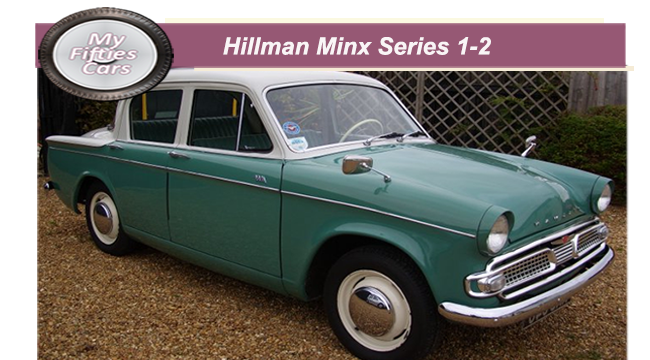 In 1956, shortly after the release of the original Sunbeam Rapier on which it was based, Rootes finally introduced the new-generation Hillman Minx.
In 1956, shortly after the release of the original Sunbeam Rapier on which it was based, Rootes finally introduced the new-generation Hillman Minx.
T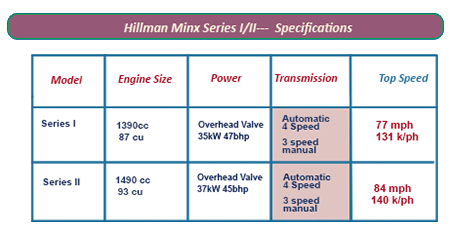 he Series 1 was set to follow in the footsteps of the long-running and successful Mark V series.
he Series 1 was set to follow in the footsteps of the long-running and successful Mark V series.
The first version of the Minx I was fitted with a 1,494cc, powerful enough for the Series I Minx, as it was now known, to achieve 70 mph, and a significant improvement on the 1390cc engine fitted in the current model, the Minx Mark VIII.

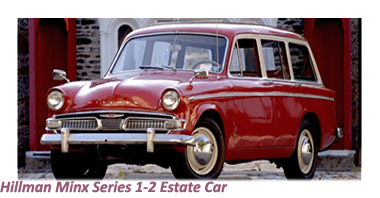 During 1956 Rootes re-vamped the Minx and gave it a new body with sculptured side panels, a much lower nose and a wrap-around rear window. The Minx’s unique body style was known as 'Audax', adapted from the Latin, meaning “bold'.
During 1956 Rootes re-vamped the Minx and gave it a new body with sculptured side panels, a much lower nose and a wrap-around rear window. The Minx’s unique body style was known as 'Audax', adapted from the Latin, meaning “bold'.
The new Minxes were a far cry from the more conservative Mark VIIIs, showing a strong American influence brought by its designer, Raymond Loewy.
Loewy came to the Rootes Group after spending several years working for US auto giant, Studebaker where he was responsible for developing some of the company’s most successful designs.
The re-vamped Minx’s entirely new body shape with its sculptured side panels, a much lower nose and a wrap-around rear window was one of the most eye-catching designs of this exciting era of the mid-Fifties,
![]()
 The model had also grown in size, with a wheelbase of 96 in (2,440 mm).with most of the extra 3'/4 in (80 mm) were for the benefit of rear-seat passengers.
The model had also grown in size, with a wheelbase of 96 in (2,440 mm).with most of the extra 3'/4 in (80 mm) were for the benefit of rear-seat passengers.
Am ong the mechanical improvements made to the Series, 2 Minx was to its front wheel suspension taken from the Sunbeam Rapier.
ong the mechanical improvements made to the Series, 2 Minx was to its front wheel suspension taken from the Sunbeam Rapier.
The Series 1 Minx’s engine was now 1,494cc, powerful enough to allow the Series I Minx to reach speeds of around 70 mph.
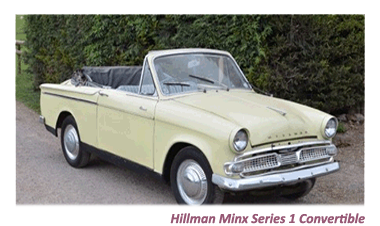 One of the most significant negative factors of the Series I Minx was Hillman’s design team decision to retain the now outmoded steering column gear-change.
One of the most significant negative factors of the Series I Minx was Hillman’s design team decision to retain the now outmoded steering column gear-change.
To their credit, Hillman rapidly put this right by offering Smith’s Easidrive automatic transmission as an option.
It soon became apparent that while Minx drivers did enjoy having an automatic gearbox they were not so fond of the Smith version.
Their negative opinions filtered back to Hillman who soon replaced it with one from Borg-Warner.
At the same time as the saloon version of the Minx was released, a Convertible was also introduced, followed, the following year by a five-door estate. A two-door drophead coupe derivative with later added to the Minx 1-2 series range.
![]()
Despite the comparatively wide range of choices throughout its production run the four-door saloon accounted for most of the sales.
Little more than one year later, in August 1957, as was typical practice at Rootes, this new-generation Minx became Series II, with a new front grille design (that Annual Model Change again!), optional Lockheed Manumatic two-pedal control, and a centre-floor gear change on entry-level Specials.
N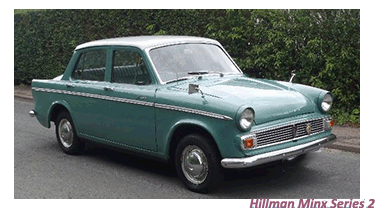 othing, however, seemed to last long at Rootes/Hillman in the 1950s, so these cars would all be supplanted by Series III models in the autumn of 1958.
othing, however, seemed to last long at Rootes/Hillman in the 1950s, so these cars would all be supplanted by Series III models in the autumn of 1958.
 In all, this version of the Minx passed through seven series, and sub-series as small changes in styling and mechanical changes were made; the original choice of 1,390cc and 1,494cc engines became a choice of 1,592ccin the final Series that survived until 1967.
In all, this version of the Minx passed through seven series, and sub-series as small changes in styling and mechanical changes were made; the original choice of 1,390cc and 1,494cc engines became a choice of 1,592ccin the final Series that survived until 1967.
Between 1956 and 1967, when the 'sculptured' body style was finally dropped, around 200,000 Minx cars in their various forms had been produced.


